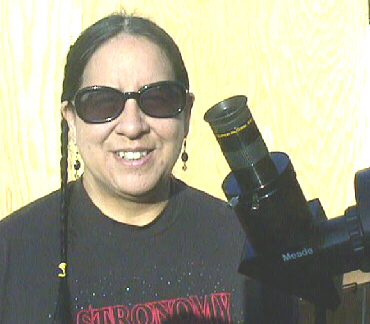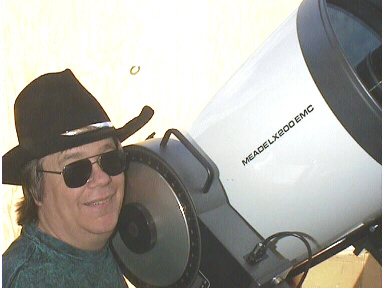Kool
Space Science Productions merges
several different interests of the founders, Carmelita Miranda
and Charles Morris. These include astronomy,
astrophotography, videography, public lecturing, and scientific
education. We hope to expand the interest in astronomy and
space science through our videos, lectures and star
shows.
So that you
will get to know us better...

Carmelita Miranda
Born in San Francisco, California a number of years ago, she
has had a number of life adventures that lead her to astronomy.
After having graduated with a BA in Education from San Francisco
State University, she got a teaching job at Los Medanos
Community in Pittsburg, Ca.
While teaching at Los Medanos Community College she found her
hobby in sailing. Learning, from the best, competitive racing on
San Francisco Bay. She had sailed competitively on many types of
sailboats from Columbia 24ís to a Swede 55. She belonged to
Berkeley Yacht Club from 1975-1982. She was asked to be a member
of the race committee for the first San Francisco to Kauai Yacht
Race in 1980. My station was the finish line underneath the
lighthouse at Nawiliwili Harbor on Kauai. To make a long sailing
story short, she came back to Cal. after the race to Kauai and
was "inspired" to buy a sailboat (a Newport 30) and
sail to Kauai to start a sailboat charter business. What does
this have to do with astronomy? She took her first formal class
on astronomy so she would know what is up in the sky during the
night watches sailing from San Francisco to Kauai, Hawaii. She
sailed to Kauai and set up her sailboat charter business in May,
1981. Then came Hurricane Iwa in Nov. 1982 and she lost her boat
and business to the hurricane.
She dabbled as a retail department manager for awhile at
Liberty House but found a more fun job working for Radio Station
KUAI/720. She started working part time on the air in 1984. She
took the full a full time position as account executive for KUAI
in 1986. In 1991, there was going to a total solar eclipse. Only
a little part of Maui and the Big Island were going to be in the
path of totality. Kauai only got 98%. While working forKUAI, she
organized a live broadcast the morning of the eclipse at the
Kauai Resort.
It was about that time that Tom Poff contacted Carmelita
about joining the Kauai Educational Association for Science and
Astronomy (KEASA, kay-saw for short). She was able to get club
members to bring telescopes and other equipment to the eclipse
site. About two thousand people lined the grounds of the Kauai
Resort and Lydgate Park to watch the eclipse. Even though we
didnít get totality, we did see it on the monitors hooked up
at the Big Island and we all had an enjoyable astronomical
event. After the eclipse she became heavily involved with
KEASA. She was the President of the club from 1991-1996. The
KEASA Observatory is located at the Pacific Missile Range
Facility (PMRF) at Barking Sands 6 miles west of Kekaha. In
Sept. 1992 Hurricane Iniki hit Kauai. It was my second
experience in a hurricane. Hurricane Iniki blew the just
finished rolling roof under the permanent roof leaving it
hanging half way to the ground. The next couple of years were
spent rebuilding the observatory. She had, by this time, started
her astrophotography interests by taking pictures of
Perseid Meteors.
Then came Comet Hyakutake (the comet that changed her life)
in 1996. She had been writing articles for "This Week
Magazine" and "The Garden Island" newspaper. She
found a web site on comet observing and made (first) contact
with Charles Morris. She asked him permission to print the Sky
Chart for Comet Hyakutake in the Garden Island. The rest,
as they say, is history.

Charles
Morris
Charles has been an amateur astronomer for over 30 years. However, he
has also been involved in astronomy on a professional level. He has a
BS in astrophysics (Michigan State) and an MS in atmospheric science (Purdue).
At night, if you can't see the stars, you are probably looking at clouds!
Hence, the career choice in meteorology.]
After a number of years as an air pollution meteorologist, Charles came
to work at the Jet Propulsion Laboratory in 1984. However, rather than
work on astronomy/planetary missions, he actually works on instruments
that look down at the Earth. These include TOPEX/Poseidon (launched 1992),
which measures sea level, NSCAT (launched 1996), which measured winds over
the ocean, and most recently, the Shuttle Radar Topography Mission
(SRTM), which flew on the shuttle in February 2000. He also authors the well-known Comet
Observation Home Page.
After seeing Comet Bennett in 1970, Charles' interest in
astronomy focused on the visual observation of comets. In particular, comet photometry or the
brightness of comets. Unlike asteroids, comets both reflect the Sun's light
and also give off their own light. Thus, a comet's brightness can be difficult
to predict and is fascinating to study. In the early 70's, Charles had an
undergraduate research grant for examining the effect of instrumentation on
visual comet estimates. In 1973, he published his first professional papers
on comets.
Charles became an avid visual observer of comets having recorded more than
250 comet apparitions. His observations were more than just looking at the
comets. He measured the comet's brightness, size and tail characteristics.
In 1985, he (and Steve Edberg) became the first people to see Comet Halley
with the naked eye since 1910. While not of scientific importance, this
observation did spark a lot of media interest. From a science perspective,
Comet Halley's apparition in 1886 was very important. Charles observed Halley's
on over 180 nights over a two year period. [This included observations from
three continents and four airplanes. There was a lot of lost sleep and an
extra 10,000 miles put on his car!] He also ran the Real-Time Observation
Network, made up of visual observers around the world, for the International
Halley Watch, which helped keep the professional community up-to-date on
Comet Halley. [You have to remember that this was before the internet!]
Both during and after the apparition, Charles analyzed Halley's light curve,
the comet's brightness as a function of time, and wrote several papers on
the subject. Over the years, he has analyzed the light curves of many comets
including several that have been the target of various spacecraft.
Charles has written more than 70 scientific papers including papers published
in the Astrophysical Journal, Astronomical Journal, and Publications of the
Society of the Pacific and the books The Study of Comets (1976) and Comets
(1981). He has also written for Astronomy magazine and Sky and Telescope
magazine. Since 1978, Charles has been the Associated Editor of the
International Comet Quarterly, a journal that serves as an archive of comet
brightness data. Although most of his scientific work has focused on comets,
Charles has also published papers on fast rotating stars, tornadoes, and
remote sensing from space.
In 1988, Charles received the Western Amateur Astronomers' Barnard Award for
his comet observing. In addition, asteroid 3783 was named "Morris" in honor
of his comet observing and research. [In 2001, asteroid 3783 comes to an
almost perfect opposition...that is, almost exactly 180 degrees from the Sun.
This is of no particular importance, but it is extremely rare.]
Charles is a member of International Astronomical Union, the American
Astronomical Society, the American Geophysical Union and the American
Association of Variable Star Observers.
ABOUT
KOOL SPACE SCIENCE | LET
US SHOW YOU THE STARS
ROCKET LAUNCHES | ECLIPSE
TOURS | WHAT'S NEW?
| GALLERY
| VIDEOS
HOME
Presented by
Carmelita Miranda
and Charles Morris.
Dream Weaver Observatory,
Fillmore, California
|